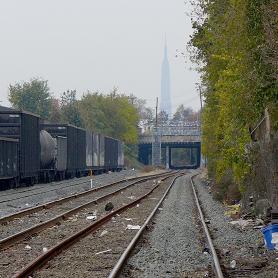Growing up as a teenager shortly after World War Two, I never viewed Glendale as a rural community. However, its tree-lined streets and well kept single-family homes did impress me. In 1947, when I looked westward down the railroad tracks from the 88th Street rail crossing, the view gave me the feeling that I had traveled to a pastoral setting. That was sixty years ago and Glendale is no longer the “Sleepy Hollow” that it was in 1947.
This was before the Long Island Expressway, the 18-wheelers, the multiple car families, over-development and congestion pricing. Back then, the rural grade crossing at 88th Street in Glendale was acceptable and safely accommodated the trickle of traffic that used this very local street. In the year 2007 “civilization” has turned Glendale into a bustling city neighborhood and 88th Street into a thoroughfare. Therefore, a railroad grade crossing at 88th Street is no longer acceptable for Glendale because in the not to distant future, increased rail traffic will add to the more than 300% increase in vehicular traffic that has taken place since 2004.
The stretch of rail that runs through Glendale is known as the Montauk Line, which the MTA, the parent of the LIRR, must upgrade to handle the proposed increase in freight traffic and provide adequate passenger service to thousands of residents from western Queens. Handicapped accessible stops at Richmond Hill, Glendale, Ridgewood and Laurel Hill are desperately needed. As we continue looking west from the 88th Street grade crossing, the old Atlas Terminal, an early 20th Century industrial complex located in Glendale, has been replaced in part by a Florida-style outdoor shopping mall, which has caused a huge increase in the vehicular traffic throughout the local communities. This location would make an excellent passenger rail stop for shoppers as well as commuters.
Traveling along the tracks further west to Ridgewood, it is my understanding, that with the 2009 reconstruction of the Fresh Pond Road/Metropolitan Avenue Bridge, the old Fresh Pond rail stop on the Montauk Line will be re-built with handicapped access. If this happens, it will relieve some of the burden from the surface transportation that serves this area. From this junction, the rails appear to be headed straight for the Empire State Building as they cross through the industrial section of Maspeth. Although the rails do not terminate under the Empire State Building, but rather in Long Island City, they have a crossover that would allow passenger trains to access Manhattan.
Our brief westward trip down the Montauk Line has revealed an egregious safety hazard – the lack of adequate fencing. This hazard, which has been photographically documented at one of the worst locations, allows vandals, thieves and possibly terrorists, to easily enter the railway. Newspapers such as the New York Times and the New York Daily News always carry stories about the Cross Harbor Freight Tunnel but they do not focus on the inadequate and deteriorated rail infrastructure. Why? Clearly, the sound barriers used on interstate highways should be installed in urban neighborhoods that warrant them. The barrier would solve two problems – unauthorized access and noise pollution.
Governor Spitzer, Mayor Bloomberg, Congressman Jerrold Nadler and our local politicians, such as Senator Serphin Maltese and Borough President Helen Marshall, should be advocating for funds to bring the Montauk Line into the 21st century. The upgrading of this rail line through western Queens, that can deliver passengers to Manhattan and western Queens residents to JFK Airport, is long overdue. The reduction in vehicular traffic, congestion, air pollution and the efficient movement of passengers and goods will provide a significant improvement in the quality of life for many New Yorkers.




